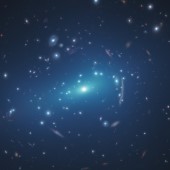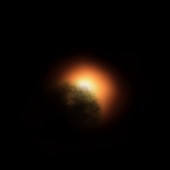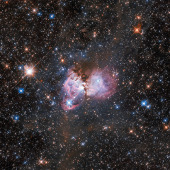ESA Science & Technology - News Archive
News archive
News archive
The 11-Jupiter-mass exoplanet called HD 106906 b occupies an unlikely orbit around a double star 336 light-years away and it may be offering clues to something that might be much closer to home: a hypothesized distant member of our Solar System dubbed "Planet Nine."
Astronomers have caught a rare glimpse of a rapidly fading shroud of gas around an aging star. Archival data from the NASA/ESA Hubble Space Telescope reveal that the nebula Hen 3-1357, nicknamed the Stingray nebula, has faded precipitously over just the past two decades.
New data from the NASA/ESA Hubble Space Telescope provides further evidence for tidal disruption in the galaxy NGC 1052-DF4. This result explains a previous finding that this galaxy is missing most of its dark matter.
The NASA/ESA's Hubble Space Telescope has tracked the fading light of a supernova in the spiral galaxy NGC 2525, located 70 million light years away. Supernovae like this one can be used as cosmic tape measures, allowing astronomers to calculate the distance to their galaxies.
This latest image of Jupiter, taken by the NASA/ESA Hubble Space Telescope on 25 August 2020, was captured when the planet was 653 million kilometres from Earth.
Observations by the NASA/ESA Hubble Space Telescope and the European Southern Observatory's Very Large Telescope (VLT) in Chile have found that something may be missing from the theories of how dark matter behaves.
The NASA/ESA Hubble Space Telescope has captured the closest images yet of the sky's latest visitor to make the headlines, comet C/2020 F3 NEOWISE, after it passed by the Sun. The new images of the comet were taken on 8 August and feature the visitor's coma, the fine shell that surrounds its nucleus, and its dusty output.
New observations by the NASA/ESA Hubble Space Telescope suggest that the unexpected dimming of the supergiant star Betelgeuse was most likely caused by an immense amount of hot material ejected into space, forming a dust cloud that blocked starlight coming from Betelgeuse's surface.
Taking advantage of a total lunar eclipse, astronomers using the NASA/ESA Hubble Space Telescope have detected ozone in Earth's atmosphere. This method serves as a proxy for how they will observe Earth-like planets around other stars in the search for life.
The young star HBC 672 is known by its nickname of Bat Shadow because of its wing-like shadow feature. The NASA/ESA Hubble Space Telescope has now observed a curious "flapping" motion in the shadow of the star's disc for the first time.
The NASA/ESA Hubble Space Telescope demonstrates its full range of imaging capabilities with two new images of planetary nebulae. The images depict two nearby young planetary nebulae, NGC 6302, dubbed the Butterfly Nebula, and NGC 7027.
New results from the NASA/ESA Hubble Space Telescope suggest the formation of the first stars and galaxies in the early Universe took place sooner than previously thought.
The NASA/ESA Hubble Space Telescope was used to conduct a three-year study of the crowded, massive and young star cluster Westerlund 2. This is the first time that astronomers have analysed an extremely dense star cluster to study which environments are favourable to planet formation.
The NASA/ESA Hubble Space Telescope has provided astronomers with the sharpest view yet of the breakup of Comet C/2019 Y4 (ATLAS). The telescope resolved roughly 30 fragments of the fragile comet on 20 April and 25 pieces on 23 April.
The NASA/ESA Hubble Space Telescope’s iconic images and scientific breakthroughs have redefined our view of the Universe. To commemorate three decades of scientific discoveries, this image is one of the most photogenic examples of the many turbulent stellar nurseries the telescope has observed during its 30-year lifetime.
What astronomers thought was a planet beyond our solar system, has now seemingly vanished from sight. Astronomers now suggest that a full-grown planet never existed in the first place.
New data from the NASA/ESA Hubble Space Telescope have provided the strongest evidence yet for mid-sized black holes in the Universe. Hubble confirms that this "intermediate-mass" black hole dwells inside a dense star cluster.
This scene of stellar creation, captured by the NASA/ESA Hubble Space Telescope, sits near the outskirts of the famous Tarantula Nebula. This cloud of gas and dust, as well as the many young and massive stars surrounding it, is the perfect laboratory to study the origin of massive stars.
The behaviour of one of nature's humblest creatures and archival data from the NASA/ESA Hubble Space Telescope are helping astronomers probe the largest structures in the Universe.
The NASA/ESA Hubble Space Telescope has imaged the majestic spiral galaxy UGC 2885, which may be the largest known in the local universe. It is 2.5 times wider than our Milky Way and contains 10 times as many stars.




















